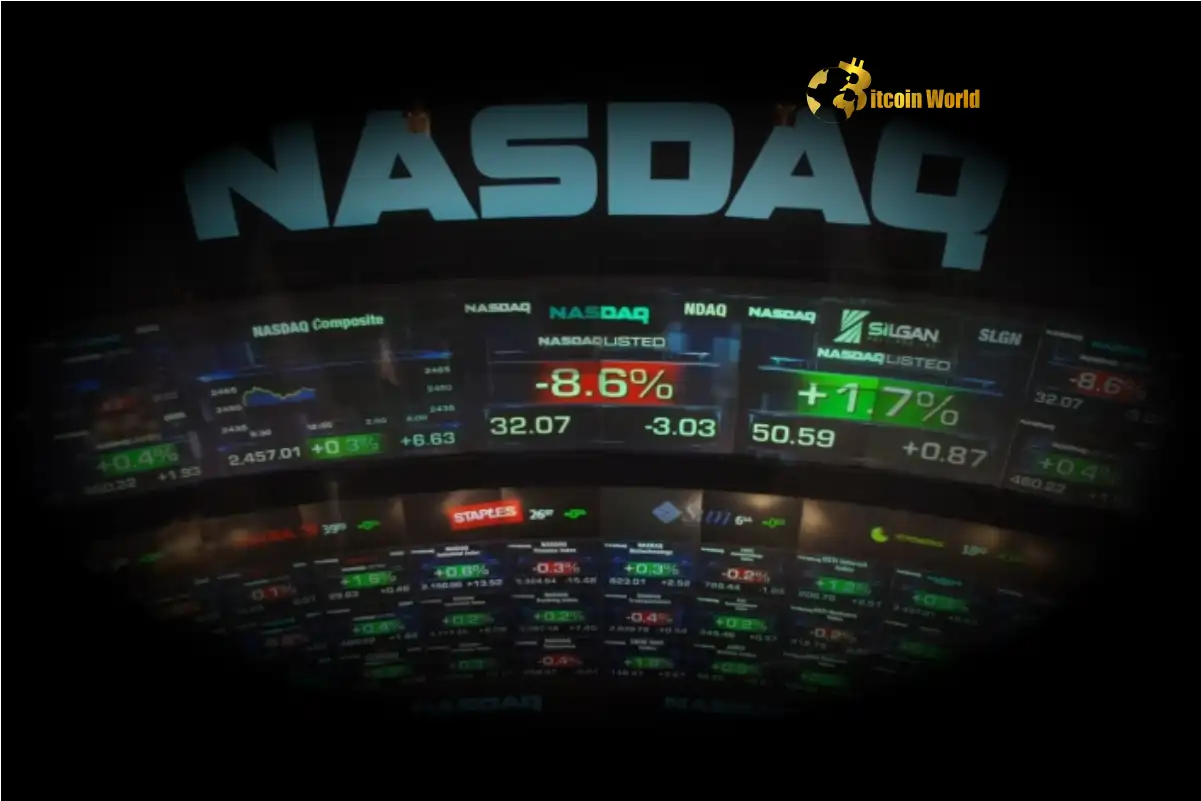Shocking Nasdaq Futures Plunge 3.5%: Decoding the Market Slide and Crypto Impact
0
0

Hold onto your hats, crypto enthusiasts! The trading winds have taken a decidedly bearish turn, and it’s not just the crypto seas getting choppy. Traditional markets are feeling the pressure too, with Nasdaq futures taking a significant nosedive. If you’re tracking market movements to inform your crypto strategy, this Nasdaq slide is a development you absolutely need to understand. Let’s dive into what’s happening and what it could mean for your digital assets.
Decoding the Shocking Nasdaq Futures Market Slide
The numbers don’t lie. As per the latest data from TradingView, Nasdaq futures (NQ1!) are currently experiencing a sharp downturn, dropping by a staggering 3.63%. To put that into perspective, the contract is now trading at 17,982.00. This isn’t just a minor dip; it’s a substantial market slide that’s sending ripples of concern across the financial world. But what exactly does this mean, and why should crypto investors care?
- Significant Percentage Drop: A 3.63% decrease in Nasdaq futures is a considerable move, indicating strong selling pressure and investor unease.
- Key Level Breached: Trading below 18,000 for NQ1! is a technically significant level, potentially signaling further downside momentum.
- Broader Market Implications: Nasdaq futures are often seen as a bellwether for the broader stock market, particularly the tech sector. This slide could foreshadow wider market weakness.
But let’s break down why this market slide in Nasdaq futures is more than just a headline – it’s a crucial indicator for anyone involved in volatile assets like cryptocurrencies.
Why Nasdaq Futures Performance Matters to Crypto Investors
You might be thinking, “Nasdaq? That’s stocks, right? What does it have to do with my Bitcoin or Ethereum?” The truth is, in today’s interconnected global financial landscape, the performance of traditional stock market indices like the Nasdaq has a growing influence on the crypto sphere. Here’s why:
- Risk Sentiment Correlation: Both the tech-heavy Nasdaq and the cryptocurrency market are often perceived as “risk-on” assets. When investor sentiment turns negative due to economic uncertainties, inflation fears, or geopolitical events, both sectors tend to experience sell-offs. A slide in Nasdaq futures can be an early warning sign of a broader risk-off mood taking hold, which can then spill over into the crypto market.
- Institutional Investment Overlap: Increasingly, institutional investors are dipping their toes into both traditional equities and digital assets. Hedge funds, family offices, and even some larger corporations are allocating capital across both Nasdaq-listed stocks and cryptocurrencies. When these institutions become risk-averse, they may reduce exposure across their entire portfolio, impacting both markets.
- Macroeconomic Signals: Nasdaq futures are sensitive to macroeconomic factors like interest rate expectations, inflation data, and economic growth forecasts. These same macroeconomic forces also significantly impact the crypto market. For example, rising interest rates can make riskier assets like both tech stocks and cryptocurrencies less attractive compared to safer fixed-income investments.
In essence, the Nasdaq futures market acts as a kind of early warning system. A significant stock market downturn there can often foreshadow similar movements, or at least increased volatility, in the cryptocurrency space. It’s about understanding the interconnectedness of global finance in the modern era.
Decoding the Drivers Behind the Futures Trading Losses
What’s fueling this concerning futures trading downturn in Nasdaq futures? While pinpointing the exact cause is always complex, several factors are likely contributing to the negative sentiment:
| Factor | Potential Impact |
|---|---|
| Inflation Concerns: | Persistent inflation remains a top concern for investors. Stronger-than-expected inflation data can raise fears of more aggressive interest rate hikes by central banks, which can negatively impact stock valuations, particularly for growth-oriented tech companies heavily represented in the Nasdaq. |
| Interest Rate Hikes: | Central banks globally are raising interest rates to combat inflation. Higher rates increase borrowing costs for companies, potentially slowing down economic growth and corporate earnings. This is especially pertinent for tech companies that rely on future growth projections for their valuations. |
| Geopolitical Uncertainty: | Ongoing geopolitical tensions and conflicts can create market volatility and uncertainty. These events can disrupt supply chains, impact global trade, and dampen investor confidence, leading to sell-offs in riskier assets. |
| Earnings Season Concerns: | As earnings season progresses, investors are closely scrutinizing corporate results and forward guidance. Any signs of weakening earnings or cautious outlooks can trigger negative reactions in the stock market, especially for high-growth sectors like tech. |
It’s a confluence of these factors that is likely creating a perfect storm, leading to the sharp decline in futures trading for Nasdaq futures.
Navigating Investment Risks in a Volatile Market
So, what should crypto investors do in the face of this investment risks and market uncertainty? Panic selling is rarely the answer. Instead, a more measured and strategic approach is advisable:
- Stay Informed: Keep a close watch on both traditional and crypto market news. Understanding the factors driving market movements is crucial for making informed decisions. Follow reputable financial news sources and analysts who provide insights into market dynamics.
- Diversification is Key: Don’t put all your eggs in one basket. Diversify your investment portfolio across different asset classes, including both crypto and traditional assets. This can help mitigate risk during periods of market volatility.
- Risk Management Strategies: Implement sound risk management strategies. This might include setting stop-loss orders to limit potential losses, gradually dollar-cost averaging into positions, or reducing overall portfolio exposure during periods of heightened uncertainty.
- Long-Term Perspective: Remember that market corrections and downturns are a normal part of the investment cycle. Focus on the long-term potential of your investments rather than reacting impulsively to short-term market fluctuations. Cryptocurrencies, despite their volatility, still hold significant long-term growth potential for many investors.
- Re-evaluate and Rebalance: Use market downturns as an opportunity to re-evaluate your portfolio. Are your initial investment theses still valid? Is your portfolio allocation still aligned with your risk tolerance and financial goals? Consider rebalancing your portfolio to maintain your desired asset allocation.
Navigating investment risks requires discipline, knowledge, and a calm head. Market volatility can be unsettling, but it also presents opportunities for informed investors who are prepared to weather the storm.
The Future Outlook: Will the Market Slide Continue?
Predicting the future of the market slide is, of course, impossible with certainty. However, we can consider a few potential scenarios:
- Continued Downward Pressure: If inflation remains stubbornly high, and central banks continue to aggressively raise interest rates, the downward pressure on Nasdaq futures and the broader stock market could persist. This could also further weigh on the crypto market.
- Short-Term Rebound: Markets often experience short-term rebounds even within broader downtrends. A temporary pause in negative news flow or slightly better-than-expected economic data could trigger a relief rally in Nasdaq futures. However, the underlying bearish trend might remain intact.
- Bottoming Out and Recovery: Eventually, the market will likely find a bottom. This could occur when inflation starts to show signs of cooling, central banks signal a potential pause in rate hikes, or geopolitical risks subside. A sustained recovery would likely require a combination of positive macroeconomic developments and improved investor sentiment.
The key takeaway is to prepare for continued volatility. The future outlook remains uncertain, and market conditions can change rapidly. By staying informed, managing risk effectively, and maintaining a long-term perspective, you can navigate these turbulent times and position yourself for potential future opportunities.
Conclusion: Staying Vigilant in a Shifting Market Landscape
The sharp slide in Nasdaq futures serves as a stark reminder of the interconnectedness and volatility of today’s financial markets. For crypto investors, it’s a crucial signal to pay attention to. While the crypto market has its own unique dynamics, it’s increasingly influenced by broader macroeconomic trends and the performance of traditional asset classes like those represented by the Nasdaq. By understanding these connections and adopting a prudent, informed approach, you can navigate the current market uncertainties and position yourself strategically for the future of both crypto and beyond. Don’t let fear dictate your decisions; instead, empower yourself with knowledge and a well-defined investment strategy.
To learn more about the latest crypto market trends, explore our article on key developments shaping Bitcoin price action.
0
0
 Manage all your crypto, NFT and DeFi from one place
Manage all your crypto, NFT and DeFi from one placeSecurely connect the portfolio you’re using to start.





